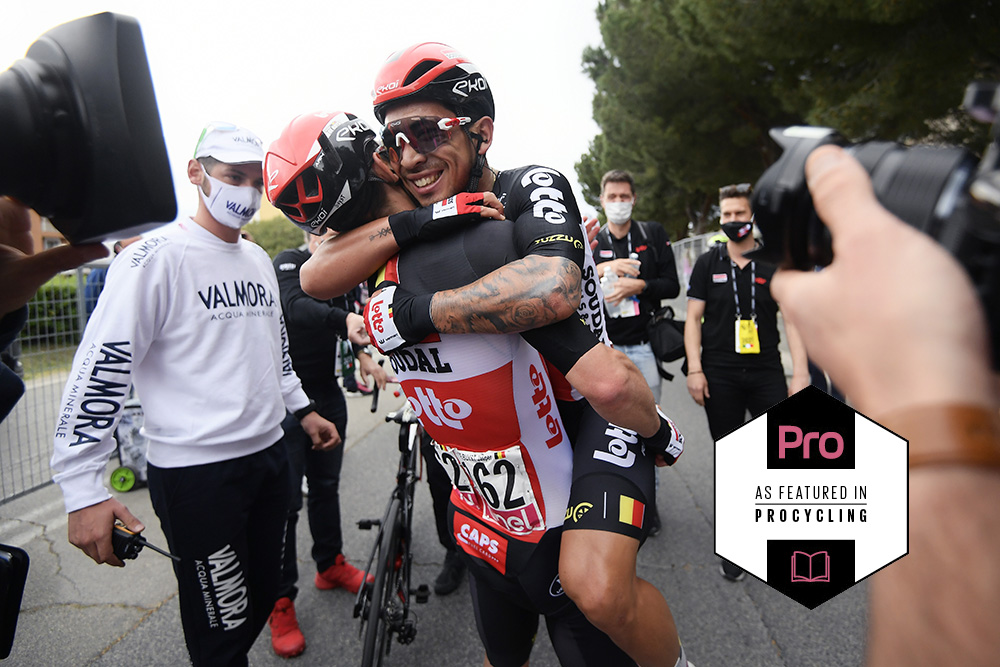Giro d'Italia stage 7 analysis: Ewan and Gaviria's long distance sprint
Caleb Ewan wins his second Giro stage thanks to a long-range sprint

If you can cast your mind back to stage 3 of Tirreno-Adriatico in 2016, you might recall a sprint finale that unfolded not too dissimilarly to stage 7 of the 2021 Giro d’Italia. The Tirreno stage, five years and 63 days ago, finished in Montalto di Castro, on the west coast of Italy rather than the east where the Giro headed in its first week but culminated on a road that dragged slightly uphill in the final kilometre, in a similar way the Giro’s stage to Termoli did.
There’s a common perception that in a bunch sprint, if all goes to plan, the last rider in a lead-out will aim to deliver their sprinter to around 200 metres to go from the finish line. Sometimes, sprinters only begin to accelerate with as little as 150m remaining - hitting and sustaining a power outage in the red that usually has to top 1,000 watts all the way to the line is best done over the shortest distance possible, of course. Start sprinting too early and, well, the chances are you’ll burn your matches too soon and get overtaken. Giacomo Nizzolo found out only too well, on stage 5 of this year’s Giro, when he was beaten at the death by Caleb Ewan.
But at the Tirreno stage back in 2016, Gaviria produced a masterclass in long-distance sprinting, if you can call it that. Then just a 21-year-old neo-pro riding for Quick-Step Floors, with no teammates left to lead him out inside the final few hundred metres he chose then world champion Peter Sagan’s wheel to sit on, before swinging out of the bunch onto the right of the road with over 250 metres to go, after a huge acceleration. The Colombian surged around the final bend, out of the saddle, his head down, and kept going, and going, and going. A late charge from another 21-year-old neo-pro, Ewan, wasn’t enough to prevent him from taking his first-ever WorldTour level victory.
Five years on and Gaviria doesn’t quite appear the same rider he was back then, having been struck by COVID-19 twice during 2020 and not yet winning a race this season. But on stage 7 of this year’s Giro, that didn’t stop him striking out early again. The only problem was that Ewan didn’t mind sprinting from far out, either.
The fact there was a short, steep climb - just 200 metres long but reaching 12 per cent gradient - with 1.6km to go made this sprint stage anything but a standard Grand Tour sprint finish. Positioning is always key, but here it was the positioning going into the right-hand turn onto the climb. Ewan knew that, with his Lotto Soudal lead-out being used up one by one not to take him to the usual drop-off point in sight of the line, but rather the foot of the climb.
Jasper De Buyst was tasked in his usual role as the last rider ahead of Ewan - nothing unusual with that, except there were still 1,600m to go when the duo were left alone. With Ewan glued to his wheel, the Belgian expertly set the pace up the climb, preventing Ewan from wasting any energy, before towing back the two riders who’d dive-bombed off the front to set up the sprint.
But when Gaviria initiated a long-range attack and jumped away from the group early with over 350m to go, Ewan immediately followed. The Australian, who said after the stage that he had anticipated an early move from the UAE Emirates rider, accelerated too, to single-handedly close down the gap that had opened up to the Colombian. With 150m remaining, Ewan then accelerated again to pass Gaviria and kick for the line. He crossed the finish completely unchallenged, more than a bike length clear to win his second stage of this year's race.
Get The Leadout Newsletter
The latest race content, interviews, features, reviews and expert buying guides, direct to your inbox!
The stats after, according to Velon, showed that Ewan sprinted for 270m, riding for 18 seconds while producing an average power of 1,010 watts. But Ewan insisted he’d been “basically sprinting from 450m to go” to catch then overtake Gaviria.
Five years ago, Gaviria proved to be an expert at long-distance sprinting, a lesson that Ewan learned. This time around, the roles had completely reversed.
Sophie Hurcom is Procycling magazine's deputy editor.
Procycling magazine: the best writing and photography from inside the world's toughest sport. Pick up your copy now in all good newsagents and supermarkets, or get a Procycling subscription.
Sophie Hurcom is Procycling’s deputy editor. She joined the magazine in 2017, after working at Cycling Weekly where she started on work experience before becoming a sub editor, and then news and features writer. Prior to that, she graduated from City University London with a Masters degree in magazine journalism. Sophie has since reported from races all over the world, including multiple Tours de France, where she was thrown in at the deep end by making her race debut in 2014 on the stage that Chris Froome crashed out on the Roubaix cobbles.